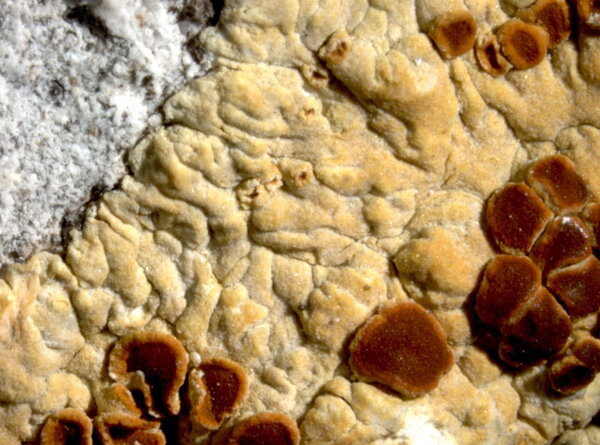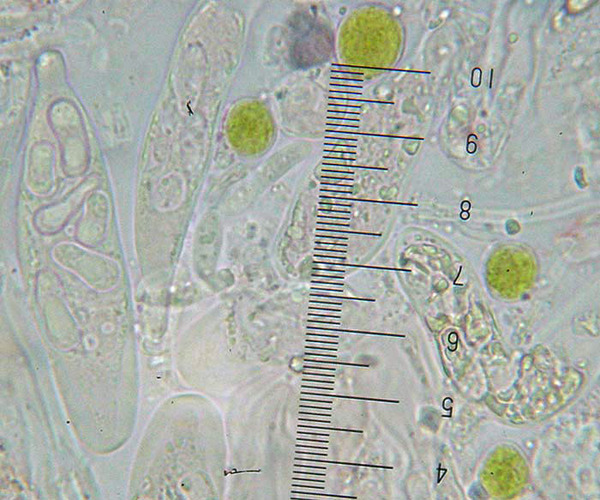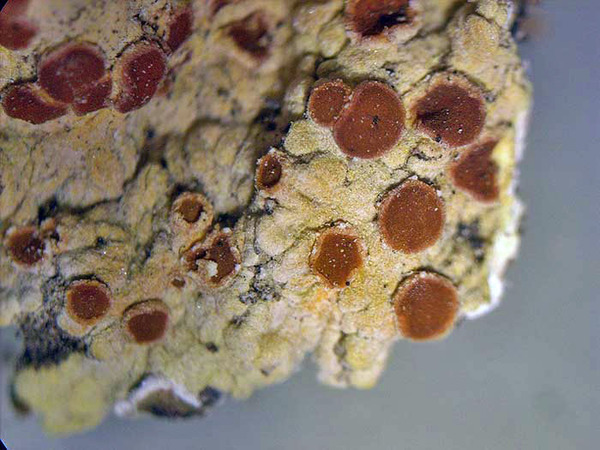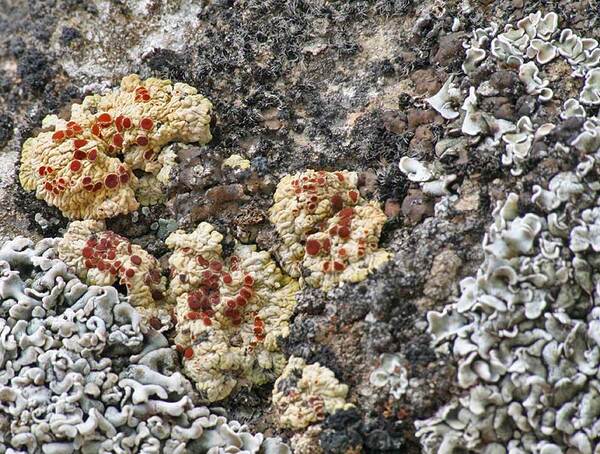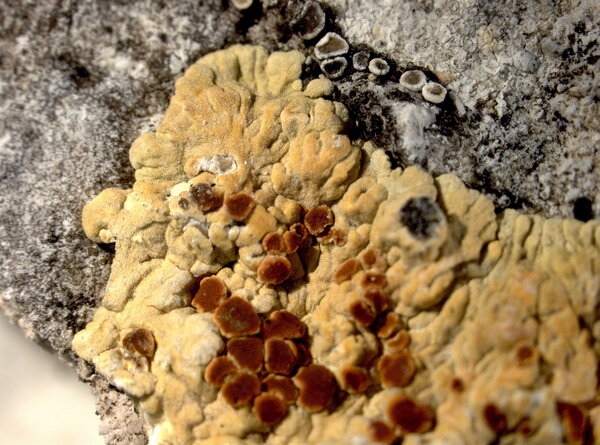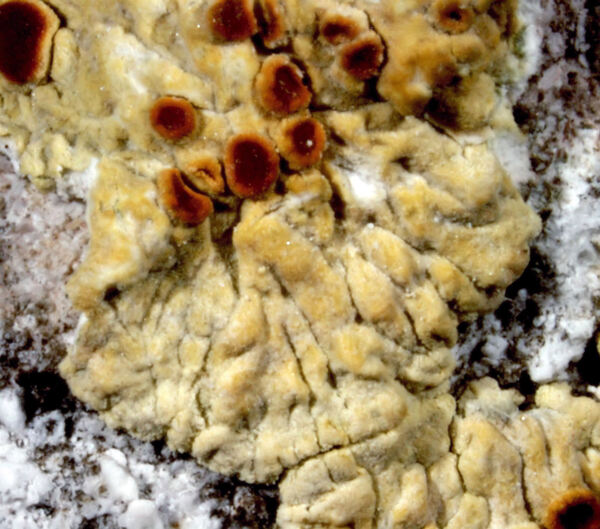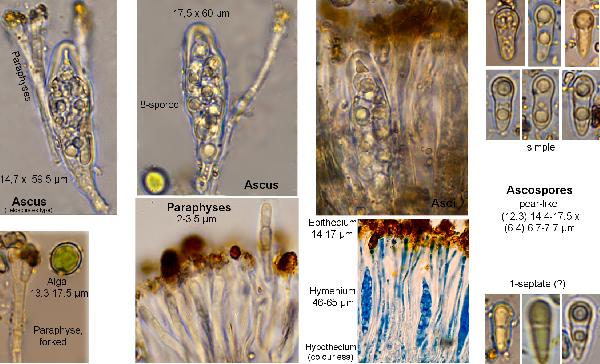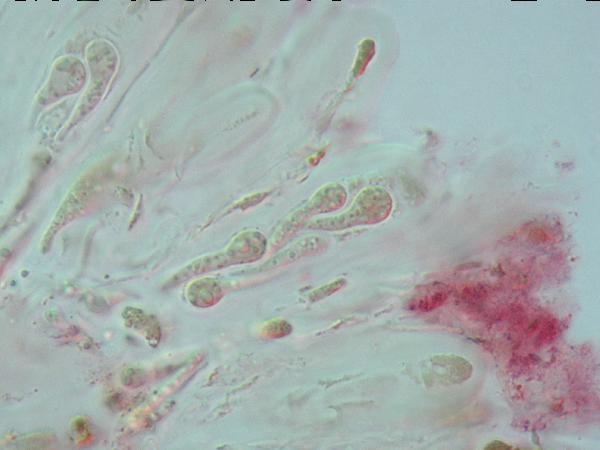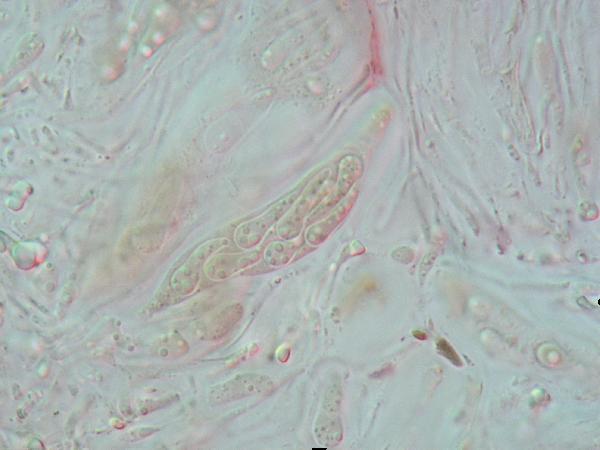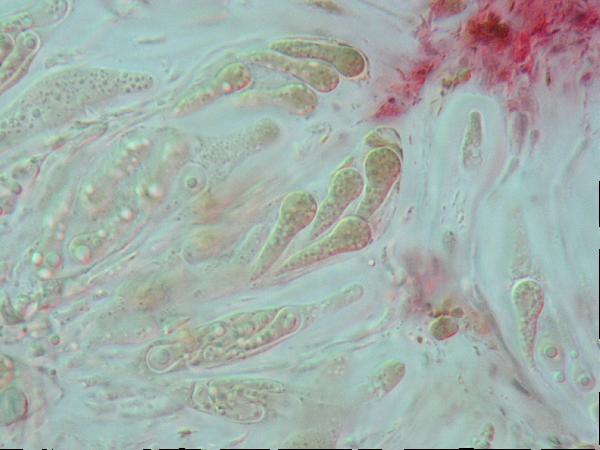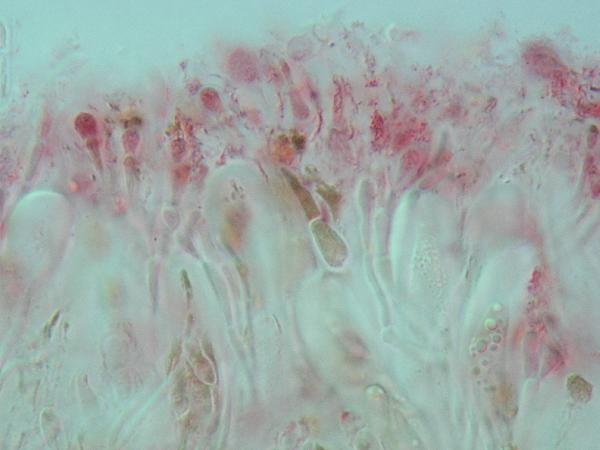Gyalolechia fulgida (Nyl.) Søchting, Frödén & Arup
in Arup & al., Nord. J. Bot., 31: 70, 2013. Basionym: Placodium fulgidum Nyl. - Flora, 58: 212, 1875.
Synonyms: Caloplaca fulgida (Nyl.) J. Steiner; Fulgensia fulgida (Nyl.) Szatala; Lecanora fulgida (Nyl.) Hue
Distribution: N - Lomb (Ravera & al. 2018), Piem (Ravera & al. 2018), Emil (Nimis & Tretiach 1999), Lig (Valcuvia & al. 2000, Giordani & al. 2025). C - Tosc (Benesperi 2006, 2007), Marc (Ravera & al. 2022b), Laz, Abr, Mol (Nimis & Tretiach 1999, Caporale & al. 2008, Brackel 2020), Sar (Harutyunyan & al. 2008). S - Camp (Garofalo & al. 1999, 2010, Aprile & al. 2003b, Nimis & Tretiach 2004, Catalano & Aprile 2008), Pugl (Garofalo & al. 1999, Aprile & al. 2003, Nimis & Tretiach 1999), Bas (Westberg & Kaernefelt 1998, Nimis & Tretiach 1999, Potenza & al. 2010, Brackel 2011), Cal (Puntillo 1996), Si (Nimis & al. 1994, 1996b, Ottonello & al. 1994, Ottonello 1996, Brackel 2008b, Gianguzzi & al. 2009).
Description: Thallus crustose-placodioid, episubstratic, yellowish white to yellow, forming orbicular to irregular, 2-8(-10) cm wide rosettes, the lobes 0.5-1 mm broad and to 6 mm long, flattened, contiguous, radiating from the central part of thallus. Apothecia lecanorine, sessile, 0.5-1.2 mm across, with an orange to brownish-orange, flat, smooth disc and a thin, orange-yellow margin which at maturity separates into an interal, darker and thinner proper margin, and an external, paler thalline margin. Epithecium orange-brown, K+ purple-red; hymenium colourless, 60-70 µm high; hypothecium colourless. Asci 8-spored, clavate, functionally unitunicate, apically thickened with a broad internal beak, the inner part of apex and external cap I+ blue, Teloschistes-type. Ascospores 1-celled, hyaline, distinctly elongated, slightly narrower in central part or subclavate, 12-20 x 5-6 µm. Photobiont chlorococcoid. Spot tests: thallus and apothecia K+ purple-red, C-, KC-, P-, UV+ pale orange. Chemistry: fragilin dominant, with smaller amounts of emodin and parietin and other anthraquinones (minor).Note: a mainly Mediterranean lichen found on rock, especially in fissures, more rarely on soil in dry grasslands, with optimum in the Mediterranean belt.
Growth form: Crustose placodiomorph
Substrata: rocks, soil, terricolous mosses, and plant debris
Photobiont: green algae other than Trentepohlia
Reproductive strategy: mainly sexual
Commonnes-rarity: (info)
Alpine belt: absent
Subalpine belt: absent
Oromediterranean belt: absent
Montane belt: absent
Submediterranean belt: rare
Padanian area: absent
Humid submediterranean belt: rather rare
Humid mediterranean belt: rather common
Dry mediterranean belt: rather common
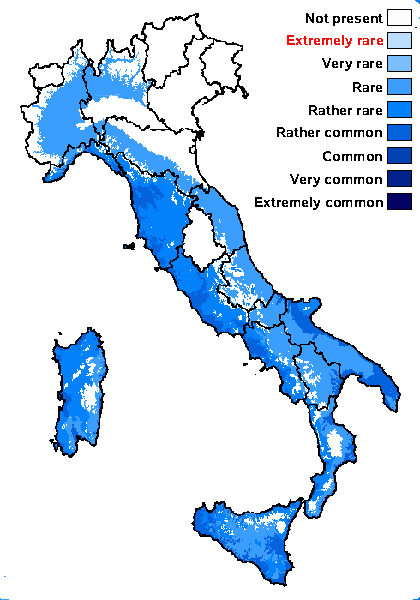
Predictive model
Herbarium samples
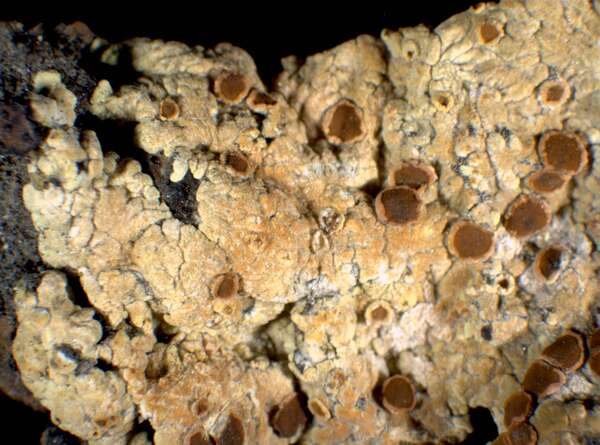

P.L. Nimis; Owner: Department of Life Sciences, University of Trieste
Herbarium: TSB (6787)
2001/11/24
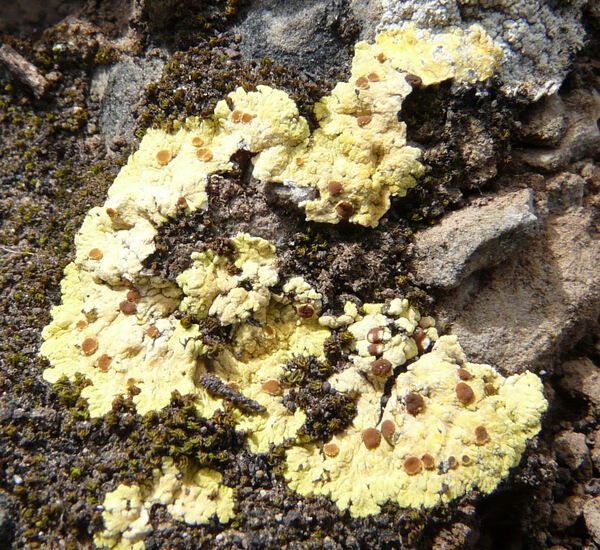

A. Moro; Owner: Department of Life Sciences, University of Trieste
Sicilia, TP, Isola di Marettimo
2008.04.03
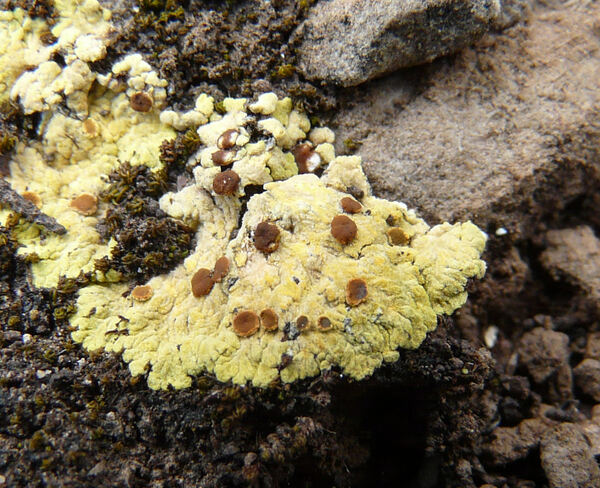

A. Moro; Owner: Department of Life Sciences, University of Trieste
Sicilia, TP, Isola di Marettimo
2008.04.03
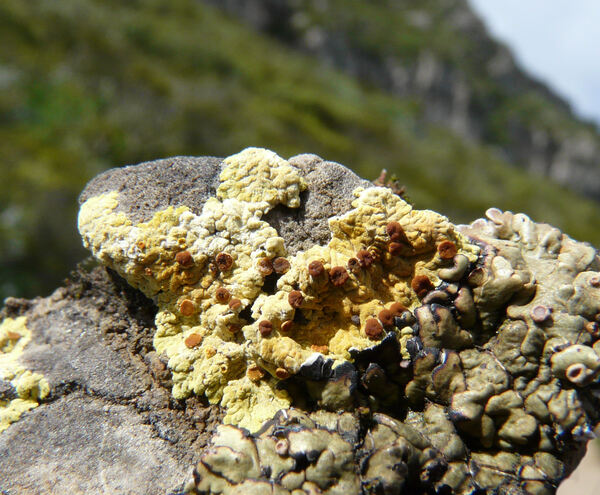

A. Moro; Owner: Department of Life Sciences, University of Trieste
Sicilia, TP, Isola di Marettimo
2008.04.03
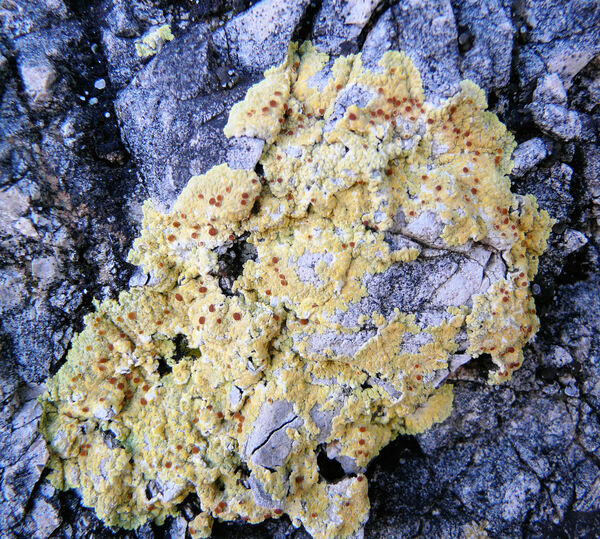

A. Moro; Owner: Department of Life Sciences, University of Trieste
Sicilia, TP, Isola di Marettimo
2008.04.03
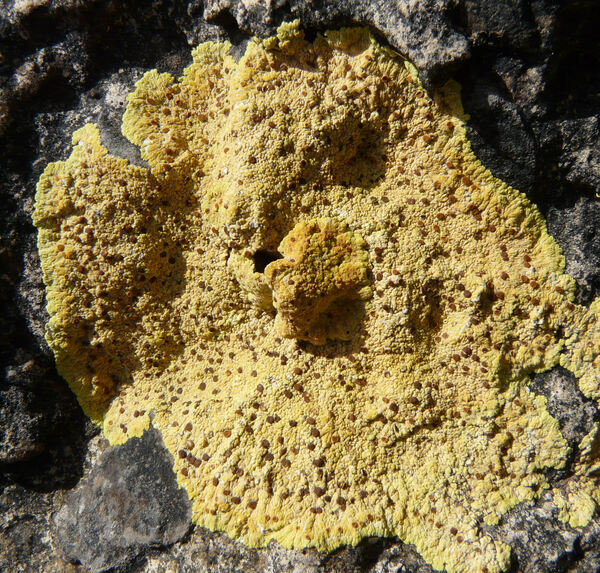

A. Moro; Owner: Department of Life Sciences, University of Trieste
Sicilia, TP, Segesta, presso i templi
2008.04.05
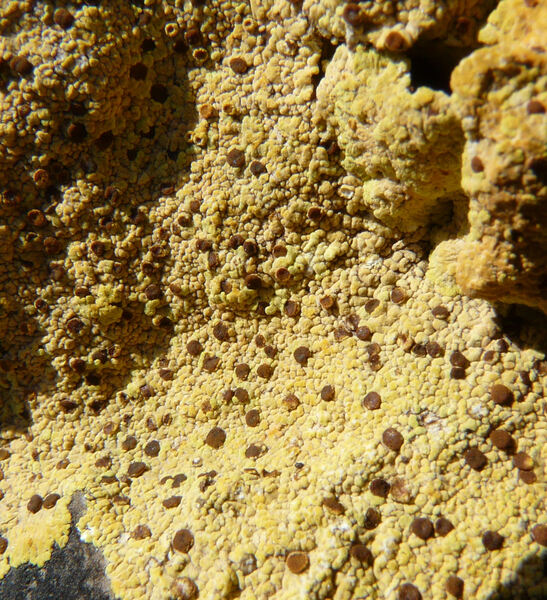

A. Moro; Owner: Department of Life Sciences, University of Trieste
Sicilia, TP, Segesta, presso i templi
2008.04.05
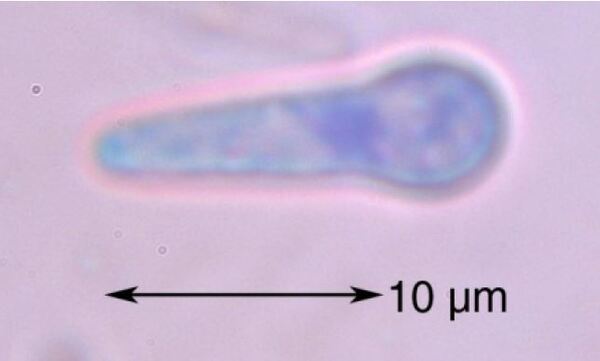

Felix Schumm - CC BY-SA 4.0
Image from: F. Schumm (2008) - Flechten Madeiras, der Kanaren und Azoren. Beck, OHG - ISBN: 978-3-00-023700-3
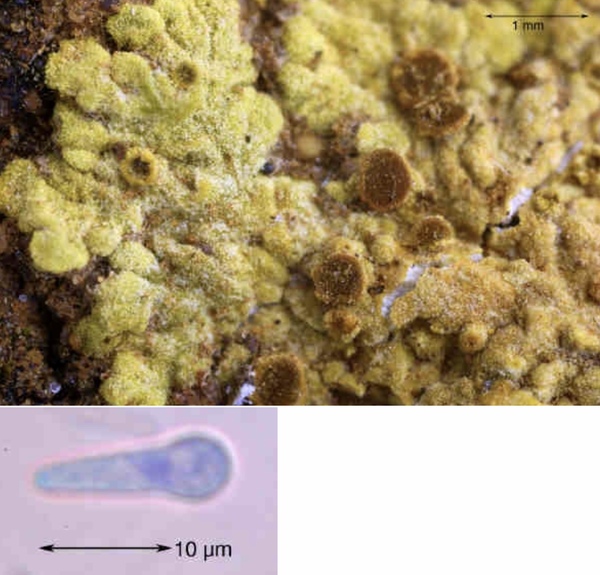

Felix Schumm – CC BY-SA 4.0
Image from: F. Schumm (2008) - Flechten Madeiras, der Kanaren und Azoren. Beck, OHG - ISBN: 978-3-00-023700-3
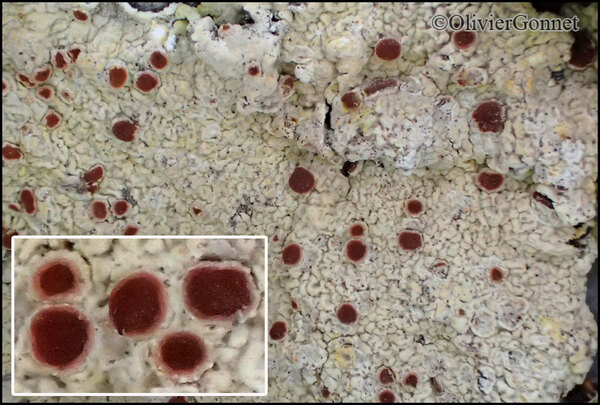
Courtesy Danièle et Olivier Gonnet - Source: https://www.afl-lichenologie.fr/Photos_AFL/Photos_AFL_G/Textes_G1/Gyalolechia_fulgida.htm
France, session AFL 2015 dans le Lot, Autoire
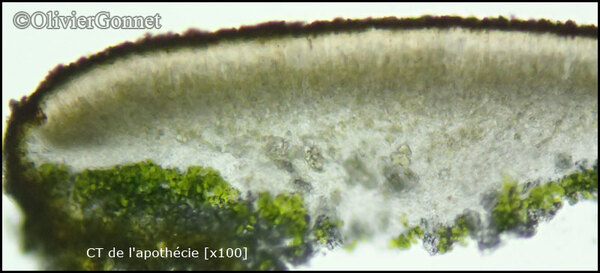
Courtesy Danièle et Olivier Gonnet - Source: https://www.afl-lichenologie.fr/Photos_AFL/Photos_AFL_G/Textes_G1/Gyalolechia_fulgida.htm
France, session AFL 2015 dans le Lot, Autoire
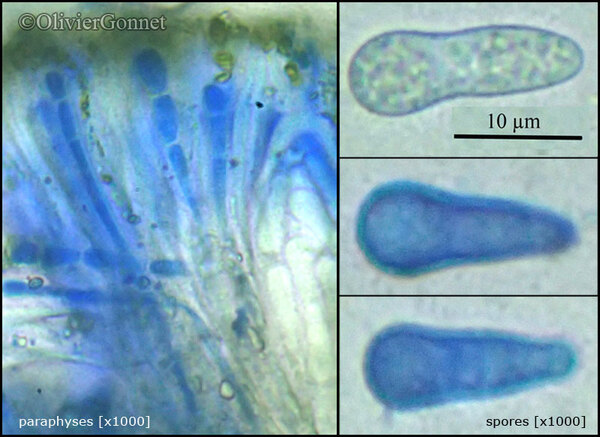
Courtesy Danièle et Olivier Gonnet - Source: https://www.afl-lichenologie.fr/Photos_AFL/Photos_AFL_G/Textes_G1/Gyalolechia_fulgida.htm
France, session AFL 2015 dans le Lot, Autoire
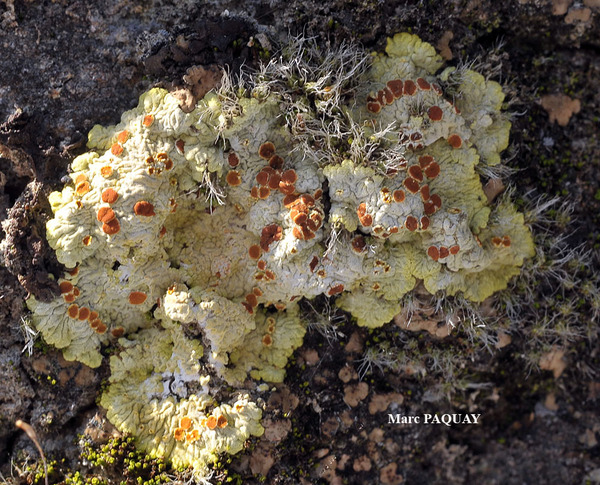
Marc Paquay - Source: http://www.lichensmaritimes.org/index.php?task=fiche&lichen=748&lang=en
France, Herault
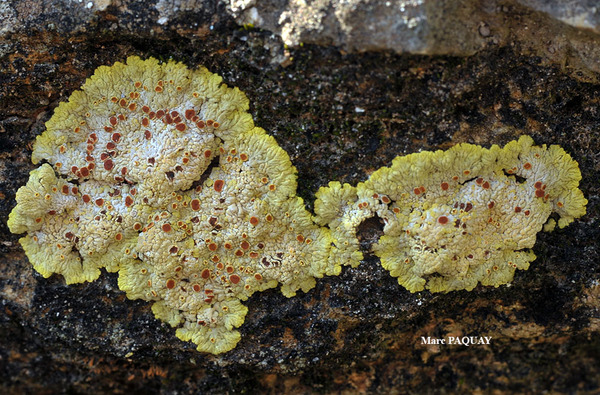
Marc Paquay - Source: http://www.lichensmaritimes.org/index.php?task=fiche&lichen=748&lang=en
France, Herault
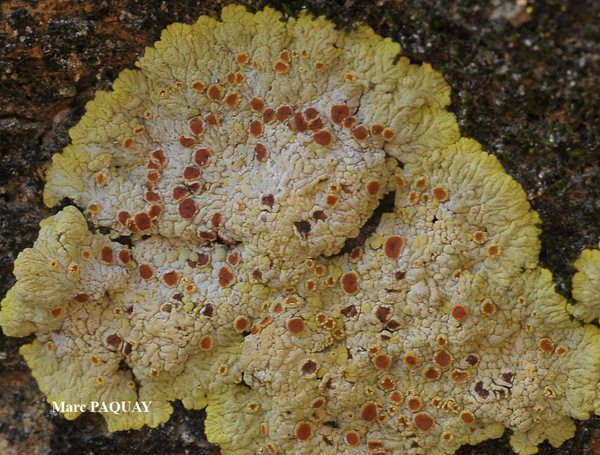
Marc Paquay - Source: http://www.lichensmaritimes.org/index.php?task=fiche&lichen=748&lang=en
France, Herault
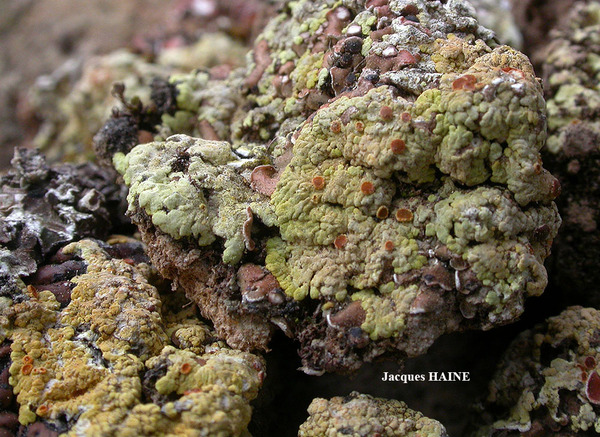
Jacques Haine - Source: http://www.lichensmaritimes.org/index.php?task=fiche&lichen=748&lang=en
France, Mt. Ventoux

Jacques Haine - Source: http://www.lichensmaritimes.org/index.php?task=fiche&lichen=748&lang=en
France, Mt. Ventoux
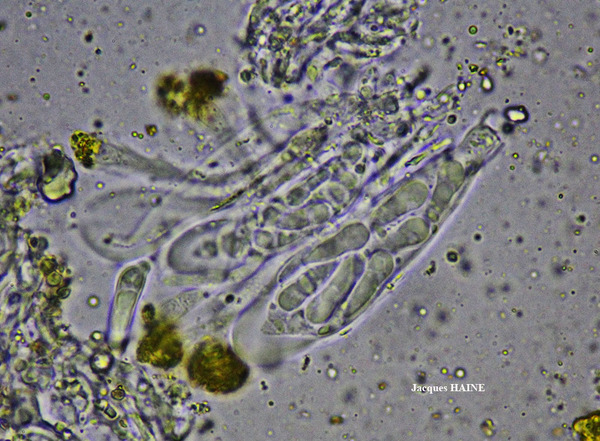
Jacques Haine - Source: http://www.lichensmaritimes.org/index.php?task=fiche&lichen=748&lang=en
France, Mt. Ventoux
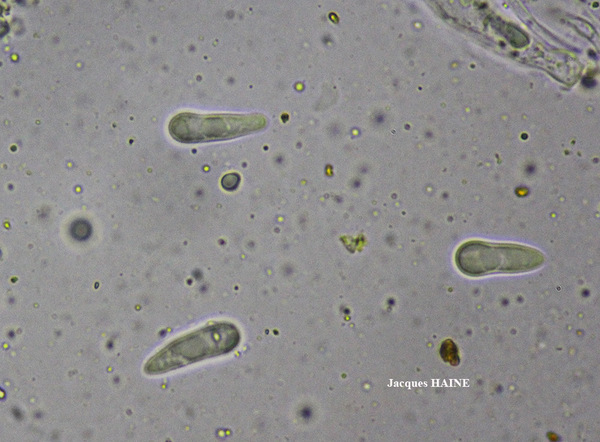
Jacques Haine - Source: http://www.lichensmaritimes.org/index.php?task=fiche&lichen=748&lang=en
France, Mt. Ventoux
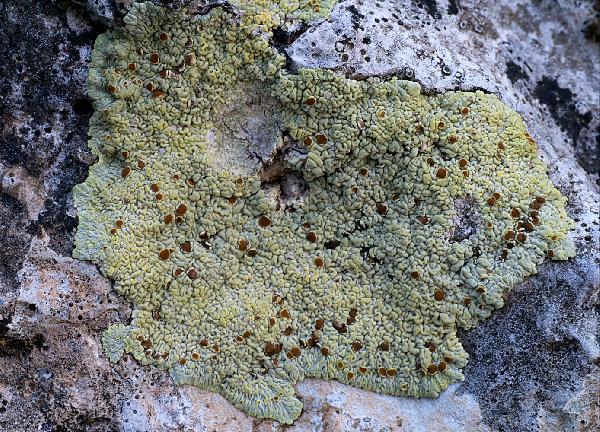
Ulrich Kirschbaum CC BY-SA 4.0 - Source: https://www.thm.de/lse/ulrich-kirschbaum/flechtenbilder
On limestone
SE-Europe; N-Cyprus; SW of Girne; Beşparmak Mountains; St. Hilarion Castle
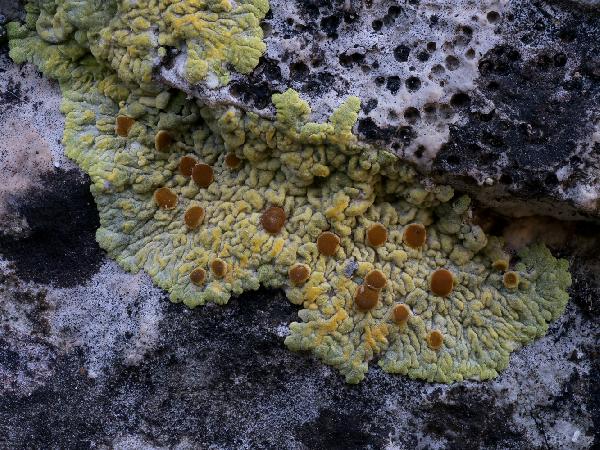
Ulrich Kirschbaum CC BY-SA 4.0 - Source: https://www.thm.de/lse/ulrich-kirschbaum/flechtenbilder
On limestone
SE-Europe; N-Cyprus; SW of Girne; Beşparmak Mountains; St. Hilarion Castle
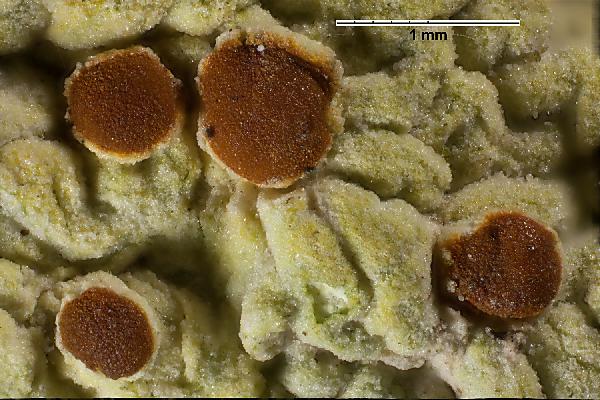
Ulrich Kirschbaum CC BY-SA 4.0 - Source: https://www.thm.de/lse/ulrich-kirschbaum/flechtenbilder
On limestone
SE-Europe; N-Cyprus; SW of Girne; Beşparmak Mountains; St. Hilarion Castle
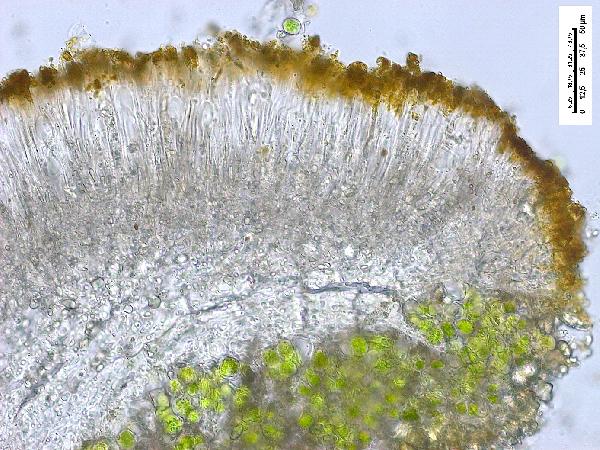
Ulrich Kirschbaum CC BY-SA 4.0 - Source: https://www.thm.de/lse/ulrich-kirschbaum/flechtenbilder
On limestone
SE-Europe; N-Cyprus; SW of Girne; Beşparmak Mountains; St. Hilarion Castle
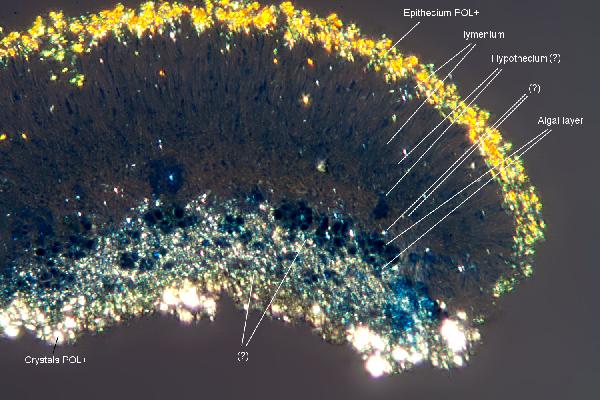
Ulrich Kirschbaum CC BY-SA 4.0 - Source: https://www.thm.de/lse/ulrich-kirschbaum/flechtenbilder
On limestone
SE-Europe; N-Cyprus; SW of Girne; Beşparmak Mountains; St. Hilarion Castle
Growth form: Crustose placodiomorph
Substrata: rocks, soil, terricolous mosses, and plant debris
Photobiont: green algae other than Trentepohlia
Reproductive strategy: mainly sexual
Commonnes-rarity: (info)
Alpine belt: absent
Subalpine belt: absent
Oromediterranean belt: absent
Montane belt: absent
Submediterranean belt: rare
Padanian area: absent
Humid submediterranean belt: rather rare
Humid mediterranean belt: rather common
Dry mediterranean belt: rather common

Predictive model
| Herbarium samples |


P.L. Nimis; Owner: Department of Life Sciences, University of Trieste
Herbarium: TSB (6787)
2001/11/24


A. Moro; Owner: Department of Life Sciences, University of Trieste
Sicilia, TP, Isola di Marettimo
2008.04.03


A. Moro; Owner: Department of Life Sciences, University of Trieste
Sicilia, TP, Isola di Marettimo
2008.04.03


A. Moro; Owner: Department of Life Sciences, University of Trieste
Sicilia, TP, Isola di Marettimo
2008.04.03


A. Moro; Owner: Department of Life Sciences, University of Trieste
Sicilia, TP, Isola di Marettimo
2008.04.03


A. Moro; Owner: Department of Life Sciences, University of Trieste
Sicilia, TP, Segesta, presso i templi
2008.04.05


A. Moro; Owner: Department of Life Sciences, University of Trieste
Sicilia, TP, Segesta, presso i templi
2008.04.05


Felix Schumm - CC BY-SA 4.0
Image from: F. Schumm (2008) - Flechten Madeiras, der Kanaren und Azoren. Beck, OHG - ISBN: 978-3-00-023700-3


Felix Schumm – CC BY-SA 4.0
Image from: F. Schumm (2008) - Flechten Madeiras, der Kanaren und Azoren. Beck, OHG - ISBN: 978-3-00-023700-3

Courtesy Danièle et Olivier Gonnet - Source: https://www.afl-lichenologie.fr/Photos_AFL/Photos_AFL_G/Textes_G1/Gyalolechia_fulgida.htm
France, session AFL 2015 dans le Lot, Autoire

Courtesy Danièle et Olivier Gonnet - Source: https://www.afl-lichenologie.fr/Photos_AFL/Photos_AFL_G/Textes_G1/Gyalolechia_fulgida.htm
France, session AFL 2015 dans le Lot, Autoire

Courtesy Danièle et Olivier Gonnet - Source: https://www.afl-lichenologie.fr/Photos_AFL/Photos_AFL_G/Textes_G1/Gyalolechia_fulgida.htm
France, session AFL 2015 dans le Lot, Autoire

Marc Paquay - Source: http://www.lichensmaritimes.org/index.php?task=fiche&lichen=748&lang=en
France, Herault

Marc Paquay - Source: http://www.lichensmaritimes.org/index.php?task=fiche&lichen=748&lang=en
France, Herault

Marc Paquay - Source: http://www.lichensmaritimes.org/index.php?task=fiche&lichen=748&lang=en
France, Herault

Jacques Haine - Source: http://www.lichensmaritimes.org/index.php?task=fiche&lichen=748&lang=en
France, Mt. Ventoux

Jacques Haine - Source: http://www.lichensmaritimes.org/index.php?task=fiche&lichen=748&lang=en
France, Mt. Ventoux

Jacques Haine - Source: http://www.lichensmaritimes.org/index.php?task=fiche&lichen=748&lang=en
France, Mt. Ventoux

Jacques Haine - Source: http://www.lichensmaritimes.org/index.php?task=fiche&lichen=748&lang=en
France, Mt. Ventoux

Ulrich Kirschbaum CC BY-SA 4.0 - Source: https://www.thm.de/lse/ulrich-kirschbaum/flechtenbilder
On limestone SE-Europe; N-Cyprus; SW of Girne; Beşparmak Mountains; St. Hilarion Castle

Ulrich Kirschbaum CC BY-SA 4.0 - Source: https://www.thm.de/lse/ulrich-kirschbaum/flechtenbilder
On limestone SE-Europe; N-Cyprus; SW of Girne; Beşparmak Mountains; St. Hilarion Castle

Ulrich Kirschbaum CC BY-SA 4.0 - Source: https://www.thm.de/lse/ulrich-kirschbaum/flechtenbilder
On limestone SE-Europe; N-Cyprus; SW of Girne; Beşparmak Mountains; St. Hilarion Castle

Ulrich Kirschbaum CC BY-SA 4.0 - Source: https://www.thm.de/lse/ulrich-kirschbaum/flechtenbilder
On limestone SE-Europe; N-Cyprus; SW of Girne; Beşparmak Mountains; St. Hilarion Castle

 INDEX FUNGORUM
INDEX FUNGORUM
 GBIF
GBIF
